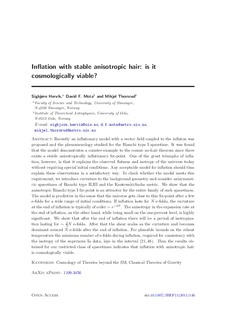| dc.contributor.author | Hervik, Sigbjørn | |
| dc.contributor.author | Mota, David F. | |
| dc.contributor.author | Thorsrud, Mikjel | |
| dc.date.accessioned | 2013-04-16T08:03:25Z | |
| dc.date.available | 2013-04-16T08:03:25Z | |
| dc.date.issued | 2011 | |
| dc.identifier.citation | Hervik, S. (2011). Inflation with stable anisotropic hair. Journal of High Energy Physics, 28(21) | no_NO |
| dc.identifier.uri | http://hdl.handle.net/11250/182385 | |
| dc.description | The final publication is available at link.springer.com; http://link.springer.com/article/10.1007/JHEP11%282011%29146. | no_NO |
| dc.description.abstract | Recently an inflationary model with a vector field coupled to the inflaton was proposed and the phenomenology studied for the Bianchi type I spacetime. It was found that the model demonstrates a counter-example to the cosmic no-hair theorem since there exists a stable anisotropically inflationary fix-point. One of the great triumphs of inflation, however, is that it explains the observed flatness and isotropy of the universe today without requiring special initial conditions. Any acceptable model for inflation should thus explain these observations in a satisfactory way. To check whether the model meets this requirement, we introduce curvature to the background geometry and consider axisymmetric spacetimes of Bianchi type II,III and the Kantowski-Sachs metric. We show that the anisotropic Bianchi type I fix-point is an attractor for the entire family of such spacetimes. The model is predictive in the sense that the universe gets close to this fix-point after a few e-folds for a wide range of initial conditions. If inflation lasts for N e-folds, the curvature at the end of inflation is typically of order ~ e −2N . The anisotropy in the expansion rate at the end of inflation, on the other hand, while being small on the one-percent level, is highly significant. We show that after the end of inflation there will be a period of isotropization lasting for ∼23N e-folds. After that the shear scales as the curvature and becomes dominant around N e-folds after the end of inflation. For plausible bounds on the reheat temperature the minimum number of e-folds during inflation, required for consistency with the isotropy of the supernova Ia data, lays in the interval (21, 48). Thus the results obtained for our restricted class of spacetimes indicates that inflation with anisotropic hair is cosmologically viable. | no_NO |
| dc.language.iso | eng | no_NO |
| dc.publisher | Springer | no_NO |
| dc.subject | string theory | no_NO |
| dc.subject | quantum physics | no_NO |
| dc.subject | elementary particles | no_NO |
| dc.subject | quantum field theory | no_NO |
| dc.subject | quantum gravitation | no_NO |
| dc.subject | gravitation | no_NO |
| dc.subject | relativity theory | no_NO |
| dc.subject | cosmology | no_NO |
| dc.title | Inflation with stable anisotropic hair | no_NO |
| dc.type | Journal article | no_NO |
| dc.type | Peer reviewed | no_NO |
| dc.subject.nsi | VDP::Mathematics and natural science: 400::Physics: 430 | no_NO |
| dc.source.volume | 11 | no_NO |
| dc.source.journal | Journal of high energy physics | no_NO |
| dc.identifier.doi | 10.1007/JHEP11(2011)146 | |
